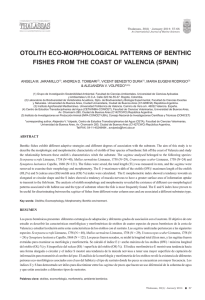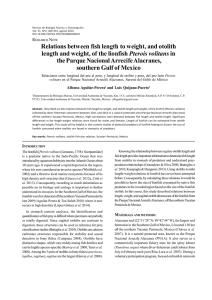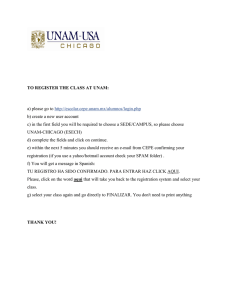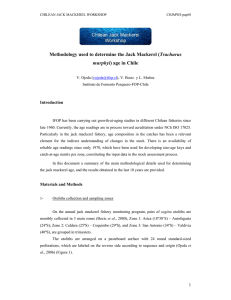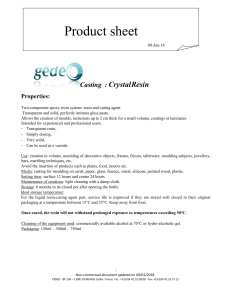Short-term clearing of opaque otoliths from larval fish
Anuncio
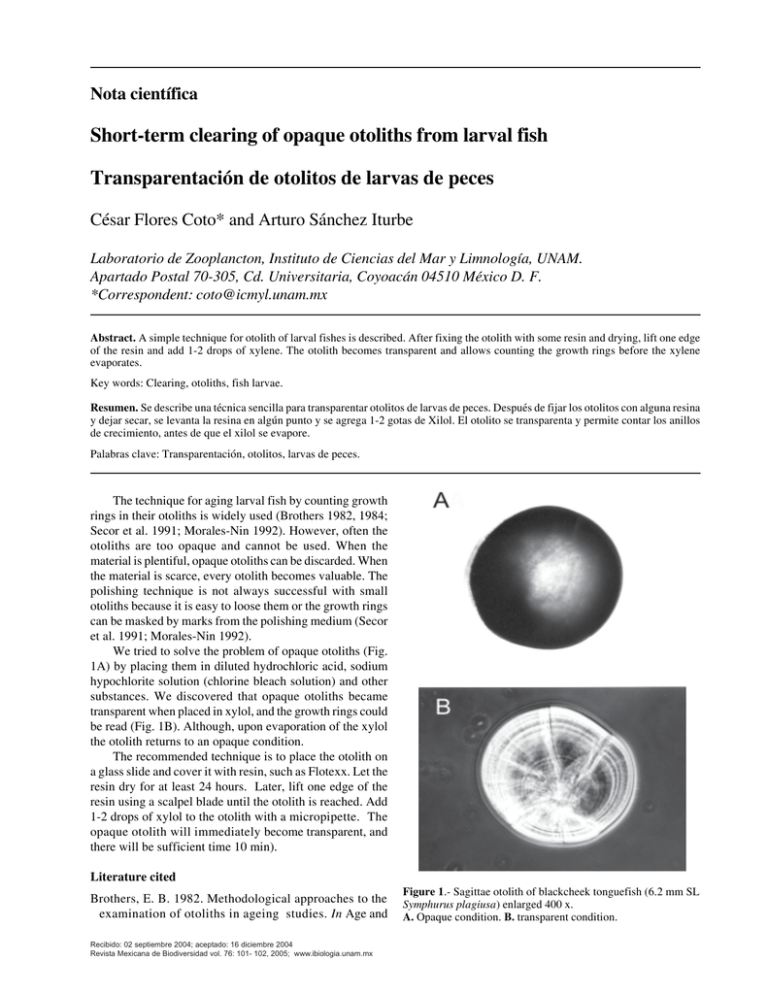
Nota científica Short-term clearing of opaque otoliths from larval fish Transparentación de otolitos de larvas de peces César Flores Coto* and Arturo Sánchez Iturbe Laboratorio de Zooplancton, Instituto de Ciencias del Mar y Limnología, UNAM. Apartado Postal 70-305, Cd. Universitaria, Coyoacán 04510 México D. F. *Correspondent: [email protected] Abstract. A simple technique for otolith of larval fishes is described. After fixing the otolith with some resin and drying, lift one edge of the resin and add 1-2 drops of xylene. The otolith becomes transparent and allows counting the growth rings before the xylene evaporates. Key words: Clearing, otoliths, fish larvae. Resumen. Se describe una técnica sencilla para transparentar otolitos de larvas de peces. Después de fijar los otolitos con alguna resina y dejar secar, se levanta la resina en algún punto y se agrega 1-2 gotas de Xilol. El otolito se transparenta y permite contar los anillos de crecimiento, antes de que el xilol se evapore. Palabras clave: Transparentación, otolitos, larvas de peces. The technique for aging larval fish by counting growth rings in their otoliths is widely used (Brothers 1982, 1984; Secor et al. 1991; Morales-Nin 1992). However, often the otoliths are too opaque and cannot be used. When the material is plentiful, opaque otoliths can be discarded. When the material is scarce, every otolith becomes valuable. The polishing technique is not always successful with small otoliths because it is easy to loose them or the growth rings can be masked by marks from the polishing medium (Secor et al. 1991; Morales-Nin 1992). We tried to solve the problem of opaque otoliths (Fig. 1A) by placing them in diluted hydrochloric acid, sodium hypochlorite solution (chlorine bleach solution) and other substances. We discovered that opaque otoliths became transparent when placed in xylol, and the growth rings could be read (Fig. 1B). Although, upon evaporation of the xylol the otolith returns to an opaque condition. The recommended technique is to place the otolith on a glass slide and cover it with resin, such as Flotexx. Let the resin dry for at least 24 hours. Later, lift one edge of the resin using a scalpel blade until the otolith is reached. Add 1-2 drops of xylol to the otolith with a micropipette. The opaque otolith will immediately become transparent, and there will be sufficient time 10 min). Literature cited Brothers, E. B. 1982. Methodological approaches to the examination of otoliths in ageing studies. In Age and Recibido: 02 septiembre 2004; aceptado: 16 diciembre 2004 Revista Mexicana de Biodiversidad vol. 76: 101- 102, 2005; www.ibiologia.unam.mx Figure 1.- Sagittae otolith of blackcheek tonguefish (6.2 mm SL Symphurus plagiusa) enlarged 400 x. A. Opaque condition. B. transparent condition. 102 Growth of fish. R. C. Summerfelt & G. E.Hall (eds.). Iowa Sate University Press, Ames Iowa, USA. p. 319330. Brothers, E. B. 1984. Otolith studies. In Ontogeny and Systematics of Fishes. H. G. Moser, W. J. Richards, D. M. Cohen, M. P. Fahay, A. W. Kendall Jr., S. L. Richardson. (eds.). Special Publication. No. 1, American Society of Ichthyologist and Herpetologist. p. 50-57. Flores y Sánchez.- Short-term clearing of otoliths Morales-Nin, B. 1992. Determination of Growth in bony fishes from otolith microstructure. FAO Fisheries Technical Paper 322. 51 p. Secor, D. H., J. M. Dean y E. H. Laban. 1991. Manual for otolith removal and preparation for microstructural otolith removal and preparation for examination. Electrical Power Research Institute and the Belle W. Baruch Institute for Marine Biology and Coastal Research, U.S.A. 85 p.
